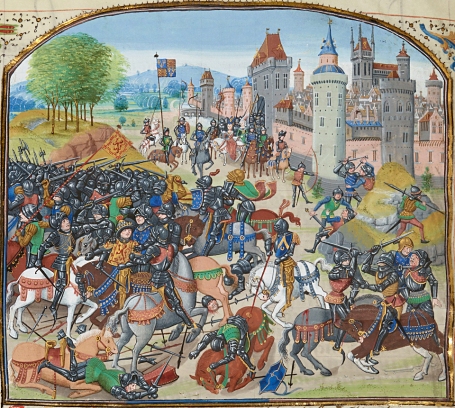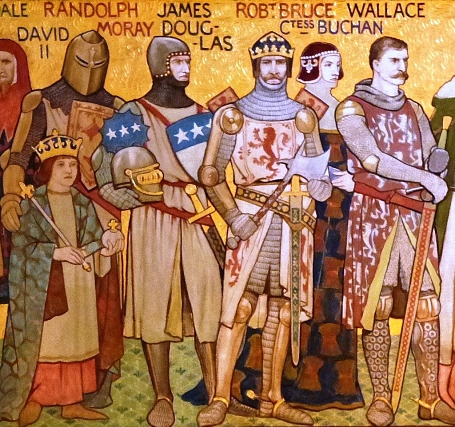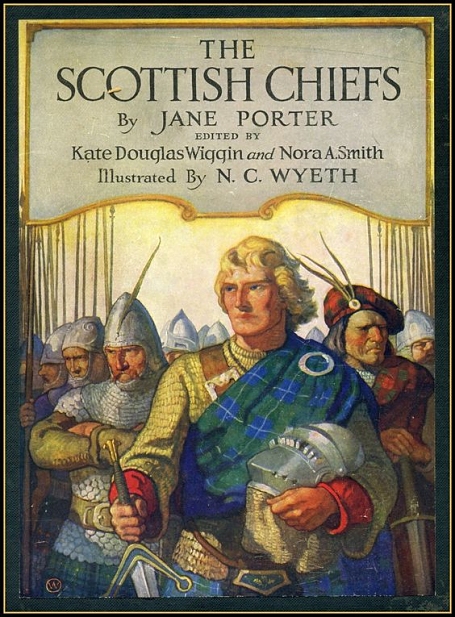The Life and Heroick Actions of the Renoun'd Sir William Wallace,
General and Governour of Scotland
by William Hamilton of Gilbertfield
Synopsis (Continued)
The armies come together in a great clash, with many killed, wounded and knocked from their horses. The Scots cut down the front line of the English army, killing five thousand. Cospatrick rallies the remains of his army, encouraging them to stand their ground. Wallace, Ramsay, Graham, Lundie, Seatoun, Adam Wallace, Hay, Lyle, Boyd, Barclay, Baird and Lauder are all given mention as killing number of English, while Cospatrick continues to fight on, putting to death many Scots. The Scots rally again with even greater force and as Cospatrick prepares to retreat, Bek's army of ten thousand suddenly arrive.
Now Wallace considers retreat, but he and his men are surrounded by Bek's men, so they fight on. Cospatrick seeks out Wallace and, despite his chain mail, gives "such a blow as wounded him a deal." Wallace strikes out at Cospatrick, but kills Maitland instead, who recklessly rides between the two. Wallace is separated from his men, surrounded by the English, his horse is wounded and he's forced to dismount and fight on foot. Cospatrick calls on spearmen to surround and kill Wallace, who responds by cutting off their heads and refusing to yield.
Graham, missing Wallace, rallies Lauder, Lyle, Hay, Ramsay, Lundie, Boyd, and Seaton, along with five hundred horse, to ride in to Wallace's rescue, trampling Bek to the ground in the charge. Wallace is given a horse and they ride off to join up with the four thousand men in their army.
Cospatrick returns to Bek, bemoaning the loss of seven thousand men; Wallace's losses were five hundred, but none of them chieftains. Bek and Costpatrick leave Lammermoor, and "all the country flocked fast" to Wallace, including Crawford of Edinburgh, men from Teviotdale, Jedburgh, and Sir William Douglas, for a total of two thousand fresh new men.
Wallace sets a watch on the area where the English have encamped, and after supper takes a force including Graham, Lauder, Hay, Seatoun, and a force of three thousand. The rest of the force Wallace commands himself; with him is Douglas, Ramsay, Barclay, Boyd, Lundie, and Adam Wallace. By the time the sun has risen they ride in and surprise the English force, killing many, chasing down those that flee, smothering some on the ground where they lay. Graham's force joins in and the ten thousand remaining English flee, with Bek fighting all the while. An English knight, named Skelton, is killed by Lundie when he attempts to defend Bek.
Eventually all the English flee; Cospatrick and Bek ride away with Bruce to Norham house as quickly as they can. The Scots pursue, killing a great number along the way, for a total loss to the English of twenty thousand.
Wallace returns from Norham, disheartened by the fact that Bruce is fighting on the English side. He marches through Cospatrick's lands, taking the goods and destroying twelve castles within the Merse and Lothian, leaving Dunbar. On the eighth day he rides to Edinburgh, and the next day on to St. Johnstoun where he meets with the barons and proclaims how he kept his vow. He then parcels out Cospatricks lands, but to his own kin he gives none, so that all might note that his goal is not to win Scotland back for himself or his family, but only for the Nation's peace and the honor of his King.
The ballad, The Life and Heroick Actions of the Renoun'd Sir William Wallace, General and Governour of Scotland, by William Hamilton of Gilbertfield, 1722, is in the public domain.

The Kingdom of England and the Kingdom of Scotland fought dozens of battles with each other. They fought typically over land, particularly Berwick-Upon-Tweed, and the Anglo-Scottish border frequently changed as a result. Read more at Wikipedia.

The First War of Scottish Independence was the initial chapter of engagements in a series of warring periods between English and Scottish forces lasting from the invasion by England in 1296 ... Read more at Wikipedia.

Digitized version of The Scottish Chiefs, by Jane Porter, a novelization published in 1921 by Charles Scribner's Sons, about William Wallace and the First Scottish War of Independence. Read online at archive.org.